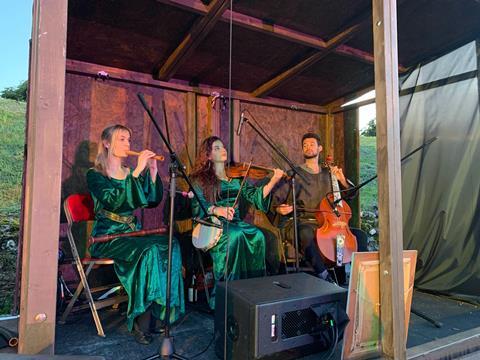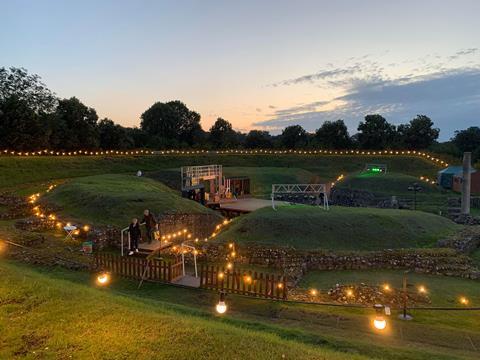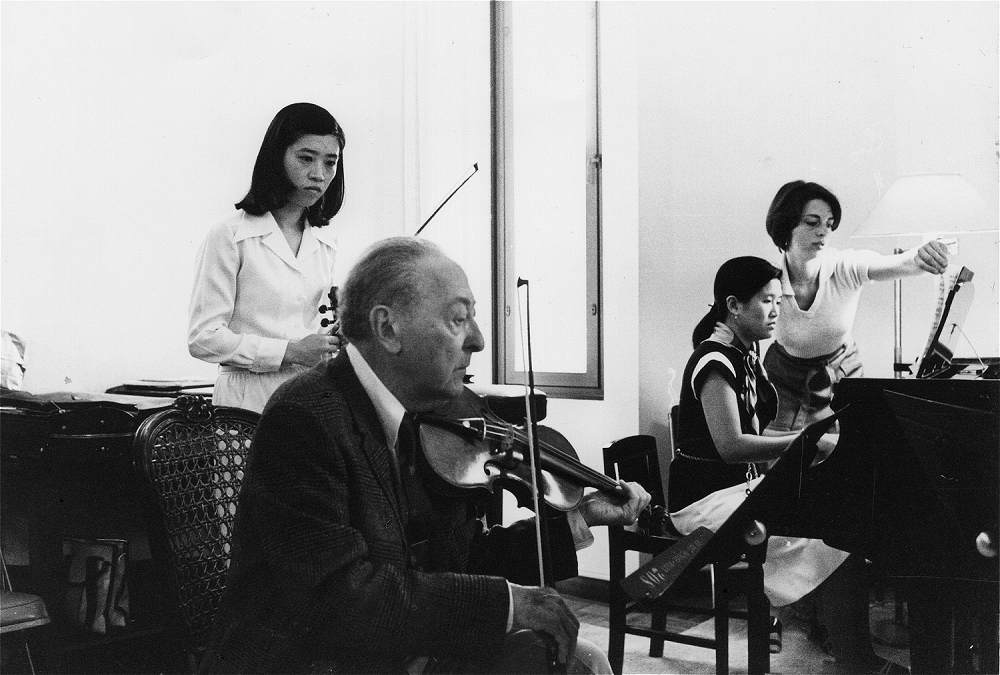In July 2023, violinist and The Strad’s staff writer Rita Fernandes took on the challenge of improvising a live soundtrack to a medieval-themed comedy improv show. She shares the process behind it and what she learnt from the experience

Discover more Featured Stories like this in The Strad Playing Hub
Imagine improvising a soundtrack to a live play in front of hundreds of people. You know the storyline and script, so you have something to hold onto, but it’s still quite difficult. Now step back and imagine improvising to a live play that you know nothing about. That’s a bit trickier. Now step back again (last time, I promise) and imagine improvising to a play neither you nor the actors know. In fact, they’re improvising too. I was recently put in this situation, and it was one of the most musically fulfilling experiences I’ve been a part of.
A large part of why I agreed to do this was because the show in question was live improv comedy, of which I am an avid fan. The show was Dream Machine’s – a London-based professional comedy improv group – ‘The Canterbury Improv Tales’, at St Albans Roman Theatre. The actors had to improvise three new Canterbury Tales also set in the 14th century, like the originals. And us musicians – Sam Whitby on viola da gamba, early music specialist Kate Allsop on recorder, and me on violin and tambourine – were to improvise medieval-style music to accompany their plays. Here’s how we went about creating this real-time medieval soundtrack, what we learnt along the way and how it has introduced me to the wonderful world of improvisation.

The music
Firstly, a quick disclaimer. Even though I referred to ‘medieval music’ above, we mostly based our improvisation on baroque musical traditions. This was largely pragmatic, as it is the style of music us classical musicians have a decent knowledge of that is closest to the stereotypical ‘medieval music’ we imagine in soundtracks and therefore associate with medieval stories such as The Canterbury Tales.
The music we played can be categorised into three types. Firstly, we compiled a list of baroque dance forms to use throughout the performance. An example was a La Folia, which has the chord progression: i-V-i-VII-III-VII-i-V-i. We would then improvise stylistically appropriate melodies on top of that bassline – not so dissimilar to the practices of the time. The melodies had to follow the action onstage. So although the basic structure was predetermined, the way in which it was manipulated was decided on the spot.
Next was unstructured accompanying music. An example was what we termed ‘travel music’. The bass-line was a repeating D-F-E on which Allsop and/or I would improvise music that suits some kind of movement in the plot. Are they travelling somewhere exciting? Add energetic rhythms. Is the plot moving in a sinister direction? Lean into the dissonances. Another example was ‘pastoral material’ when any nature-related themes came up. Whitby played an F drone and we improvised in F lydian on top.
The last type was sound effects. ‘Just a low drone or some creepy sounds go a long way to evoke a mood, and this comes so naturally it doesn’t really require practising,’ says Whitby.
The role of the music
One thing that surprised us all when we first combined music and acting was how much influence the music had on the plot. If the actors said one thing, we could immediately subvert it by playing music that holds other subconscious connotations. ‘The music completely changed the way we performed as improvisers,’ says Felix Grainger, an actor in the group and co-founder of Make It Beautiful theatre company, which organises the Dream Machine’s performances. ‘I was surprised at how it allowed us to slow down and relish scenes that previously we may have rushed through.’
Although fun, we realised this couldn’t go too far either. The question was: should the music have rhetorical power or just accompany the actors? Too much of the former could sabotage the actors’ larger story arc but too much of the latter would make a live band redundant. By laying down a few ground rules we found a (hopefully) functional middle ground.
Read: ‘When someone is healthy inside, it sounds that way’ - Mental health services in conservatoires
Read: Cellist Joanna Borrett: Can we revive the link between playing and improvising?
Ground rules
Firstly, to avoid total chaos, we needed a leader. Seeing as he was playing the basslines, Whitby took on the role. By listening to the actors, he would assess which dance form would suit the action best, start playing its bassline and we would improvise on top.
Next: less is more. It became important to know when not to play. If someone takes initiative, this doesn’t mean we should all play. Limited instrumentation creates a contrast. The audience may ask, ‘Why is the recorder only playing? Has something happened in the plot I’m not aware of?’ Furthermore, if you play too often, you become redundant as there is no contrast in what you’re doing; the audience will start forgetting you’re there. So moments of silence were very important.
It also goes for your playing. Showing off with complicated melodies is rarely warranted; it is too much risk for too little reward. And the attention you’ll spend on playing accurately will mean attention turned away from collaborating effectively with the actors.

Taking risks and embracing freedom
The most obvious difference between non-improvised and improvised performance is risk. Our training as classical musicians is geared towards avoiding risk. For example, we practise pieces faster than we will play them. These measures are in service of a noble goal, but they are nevertheless risk-avoidant. It’s no surprise that many classical musicians say ‘I can’t improvise’ when a fear of risk is a fundamental part of our training.
I also believe there is a misunderstanding about what improvisation actually is. When people say they can’t improvise, ‘this speaks to the correctly daunting horror of a blank tonal slate,’ says Whitby. ‘Once you’ve got a good constraining harmonic structure, like the blues’ – or baroque basslines in this case – ‘I find most musicians can improvise melodic and rhythmic fragments.’
Learning to take those risks and to embrace the freedom of improvisation is an ongoing process. And what I try to do if I get overwhelmed is to go back to basics. When you think about it, we improvise every day of our lives. If a waiter tells you they’re out of muffins, and only have carrot cake or brownies left, I’d bet most of us wouldn’t sprint out of the café shouting ‘I can’t improvise!’ out of fear of choosing the ‘wrong’ dessert. And as musicians, I’d argue that music is the medium through which we can improvise best. Most of us have had decades of practice to acquire a high level of technical and musical proficiency. Now when improvising, I often find myself demonstrating technical or aural skills I didn’t even realise I had. Taking risks forces you to tap into all that knowledge you’ve built up throughout the years but forgotten you had by playing the same repertoire over and over again.
It’s no surprise that the most memorable parts of the performance were ones in which we took risks. For Allsop it was ‘where we went “off script”, because of a particular material on stage we were reacting to’. For me it was when things inexplicably synchronised between musicians and actors – when everyone was taking full advantage of the freedom we had to create something totally new in that moment.
Back to the basics
Improvising has made me reconnect with what I love about music. Especially when performing alongside another art form, you are confronted with what makes music unique. In this case, I experienced music’s ability to speak to the subconscious in real time, and its power to influence how someone perceives what surrounds them in that moment. It’s nice to, just once and a while, be reminded of why you love what you do!
You can learn more about the Make It Beautiful theatre company here
Read: Opinion: Live for the moment
Read: Tartini’s Devil’s Trill meets Klezmer-style improvisation
Discover more Featured Stories like this in The Strad Playing Hub
The number one source for playing and teaching books, guides, CDs, calendars and back issues of the magazine.
In The Best of Technique you’ll discover the top playing tips of the world’s leading string players and teachers. It’s packed full of exercises for students, plus examples from the standard repertoire to show you how to integrate the technique into your playing.
The Strad’s Masterclass series brings together the finest string players with some of the greatest string works ever written. Always one of our most popular sections, Masterclass has been an invaluable aid to aspiring soloists, chamber musicians and string teachers since the 1990s.
American collector David L. Fulton amassed one of the 20th century’s finest collections of stringed instruments. This year’s calendar pays tribute to some of these priceless treasures, including Yehudi Menuhin’s celebrated ‘Lord Wilton’ Guarneri, the Carlo Bergonzi once played by Fritz Kreisler, and four instruments by Antonio Stradivari.
Reference













































No comments yet